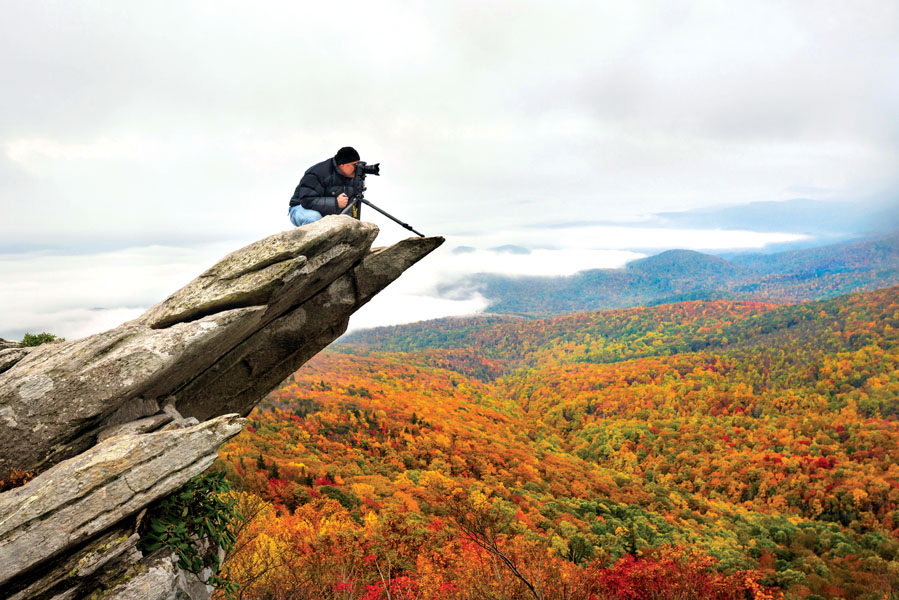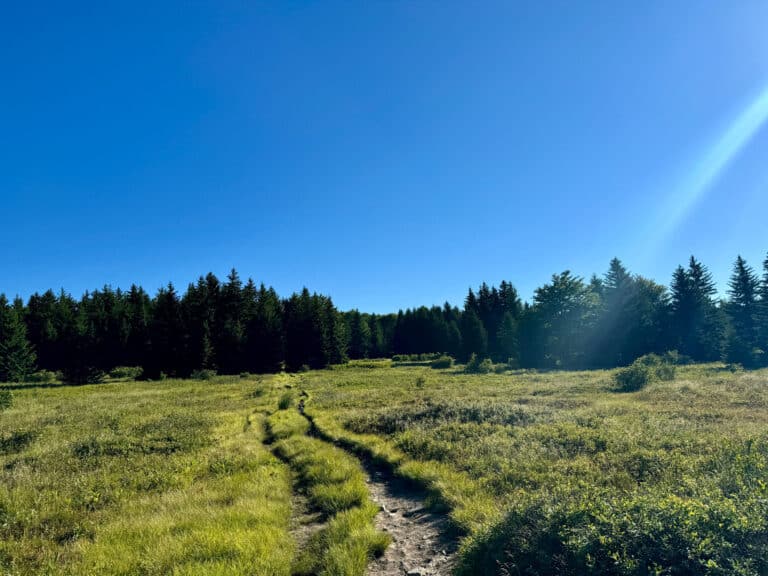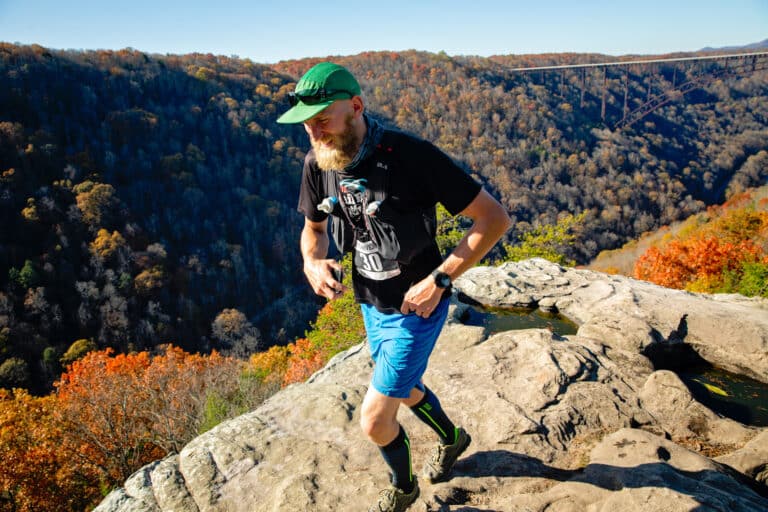Good adventure photography inspires its viewer to explore, dream, discover, but what really goes on behind the lens is less than picture perfect. We sat down with 14 regional outdoor photographers to glean the unfiltered stories of hard work, stubborn perseverance, and sometimes, damn good luck, that goes into getting the shot (and how you can get it too).
WHEN TALENT FLIES
Based in: Asheville, N.C.
Started shooting in: 2004
Specializes in: Adventure sports and lifestyle
Shoots on: Sony Alpha a9 with Sony 24-70mm f/2.8 lens
Most memorable photography faux pas: Accidentally erasing all of the images for an editorial assignment to shoot Vice President Dick Cheney’s speech at the opening of Grand Teton National Park’s new visitor center.
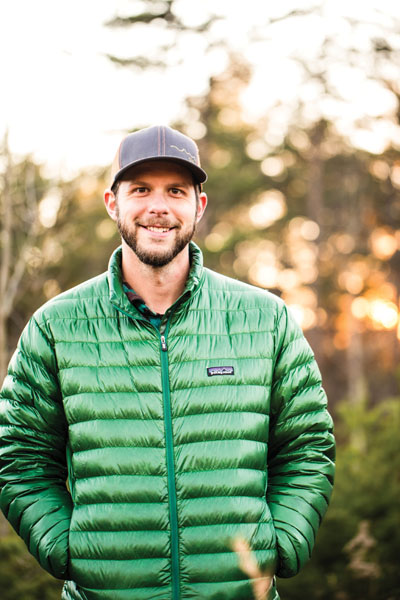
Mountain biking by nature is an accident-prone sport. Derek DiLuzio has seen his friends break bones, bust bikes. It comes with the territory. During one particularly memorable shoot, a friend was sessioning a 25-foot jump at Bailey Mountain Bike Park in Marshall, N.C. The two had a rhythm going—DiLuzio got into position, signaled the ready, rider dropped in, shutter snapped. The going was good. But then his friend cruised down, unannounced, and landed a perfect 360, the only one attempted that day. And DiLuzio missed the shot.
“Nobody had done a 360 off that jump period,” he says. “I wasn’t anticipating it. There was no communication. He just went for it.”
DiLuzio convinced his friend to try again, and this time, he would be ready. He situated himself beneath the jump, gave the rider the green light, and started snapping away. This time, his friend didn’t stick the 360. He bailed at the height of the jump, falling more than 25 feet to the ground.
“That picture is moments after he kicked the bike away,” DiLuzio remembers. “He didn’t break anything but he bruised his heels and couldn’t walk for a week. He banged himself up pretty good, all because I missed the picture.”
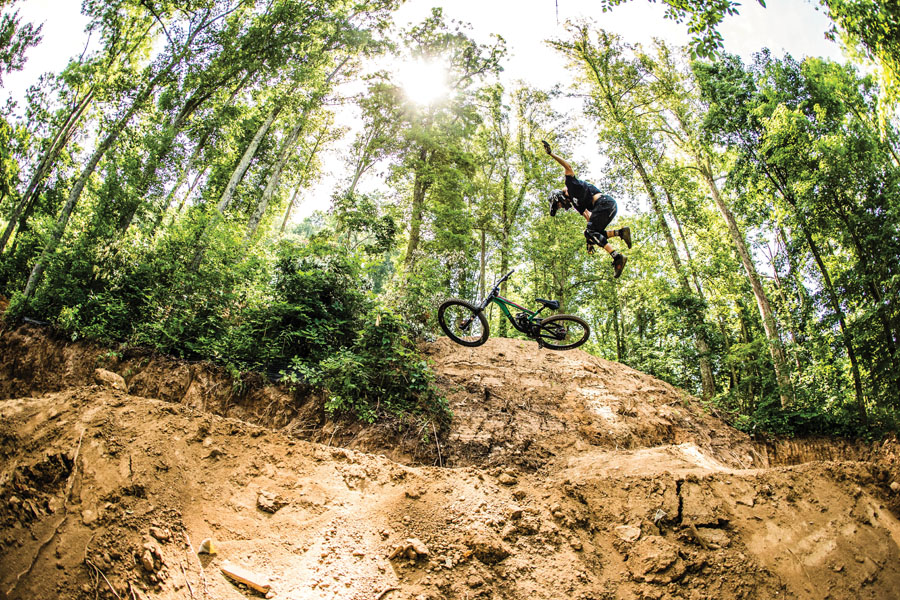
Derek’s Takeaways
• Clear communication is key.
• Don’t delete images in the field.
• Shoot on duplicate SD cards.
THE WAITING GAME
Based in: Roanoke, Va.
Started shooting in: 2015
Specializes in: Adventure sports
and landscapes
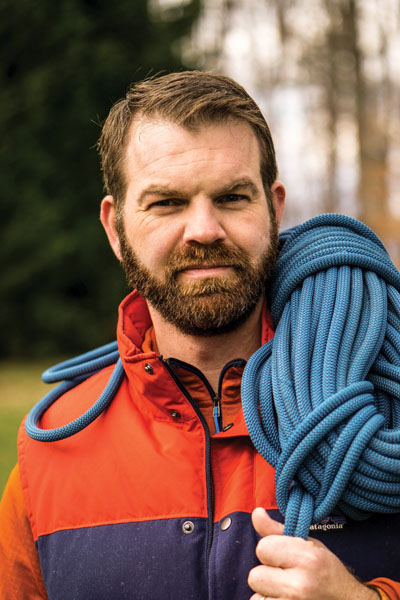
Shoots on: Sony A7R II with Sony 16-35mm f/2.8 lens
Most memorable photography faux pas: Leaving a $3,000 camera and tripod setup on Spy Rock while making camp, only to have both stolen from two hikers.
Operating at all hours of the night, rising well before dawn. Kenton Steryous is used to going out while everyone else is fast asleep. His seven-year-old son Ethan, however, is not. That didn’t stop Ethan from asking his father if he could tag along for his next late night excursion, a night hike to McAfee Knob to shoot the Milky Way.
“I wasn’t sure what was even possible to get, but Ethan told me he really wanted to do this,” Steryous says. “The hardest part was getting him awake out of bed.”
The forecast called for the clouds to clear around 3 a.m., so Steryous, Ethan, and a couple of friends set out on the 4.4-mile, 1,700-foot ascent at one o’clock in the morning. When they arrived at the rocky expanse some two hours later, the clouds still had not cleared. Even worse, the temperature was down in the 40s and the wind was brutal. Steryous shot for a half-hour, but knew in his heart the Milky Way image was a bust.
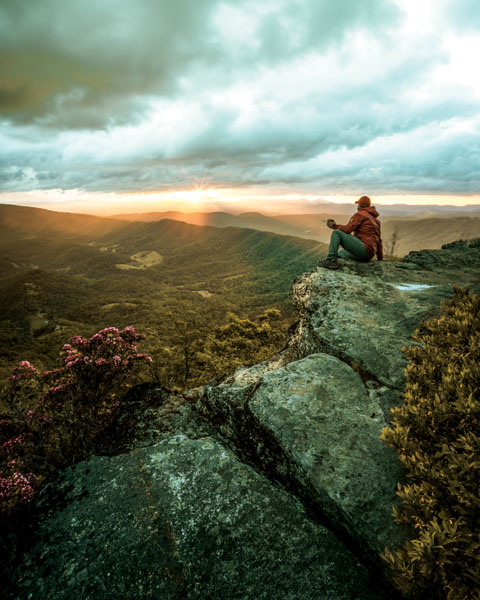
Ethan, who until that point had been a total trooper, started to get cold. He asked if they could go back to the car, but Steryous wasn’t about to turn around just yet. He set up a hammock, gave Ethan his spare jacket, and settled in for the long wait till sunrise. Three hours later, just before 7 a.m., the heavens parted
“My first thought was, ‘man I’m so glad I stayed.’ So often as a photographer, you go out with a particular objective in mind and if that doesn’t happen, it’s so easy to just turn around and go home,” says Steryous, especially when you’re cold to the bone and have a seven-year-old in tow.
Kenton’s Takeaways
• Use graduated neutral density filters.
• Shoot a place you’re familiar with at different times of the day and during different seasons in the year.
• Have patience in spades.
[nextpage title=”Read on!”]
SHOOTIN’ THE MONKEY
Based in: Atlanta, Ga.
Started shooting in: 2012
Specializes in: whitewater paddling
Shoots on: Canon 5D with a Sigma 12-35mm f/1.8 lens
Most memorable photography faux pas: Slipping on a wet patch of rock while shooting paddlers and sliding into the waist-deep river with a fully loaded camera pack.
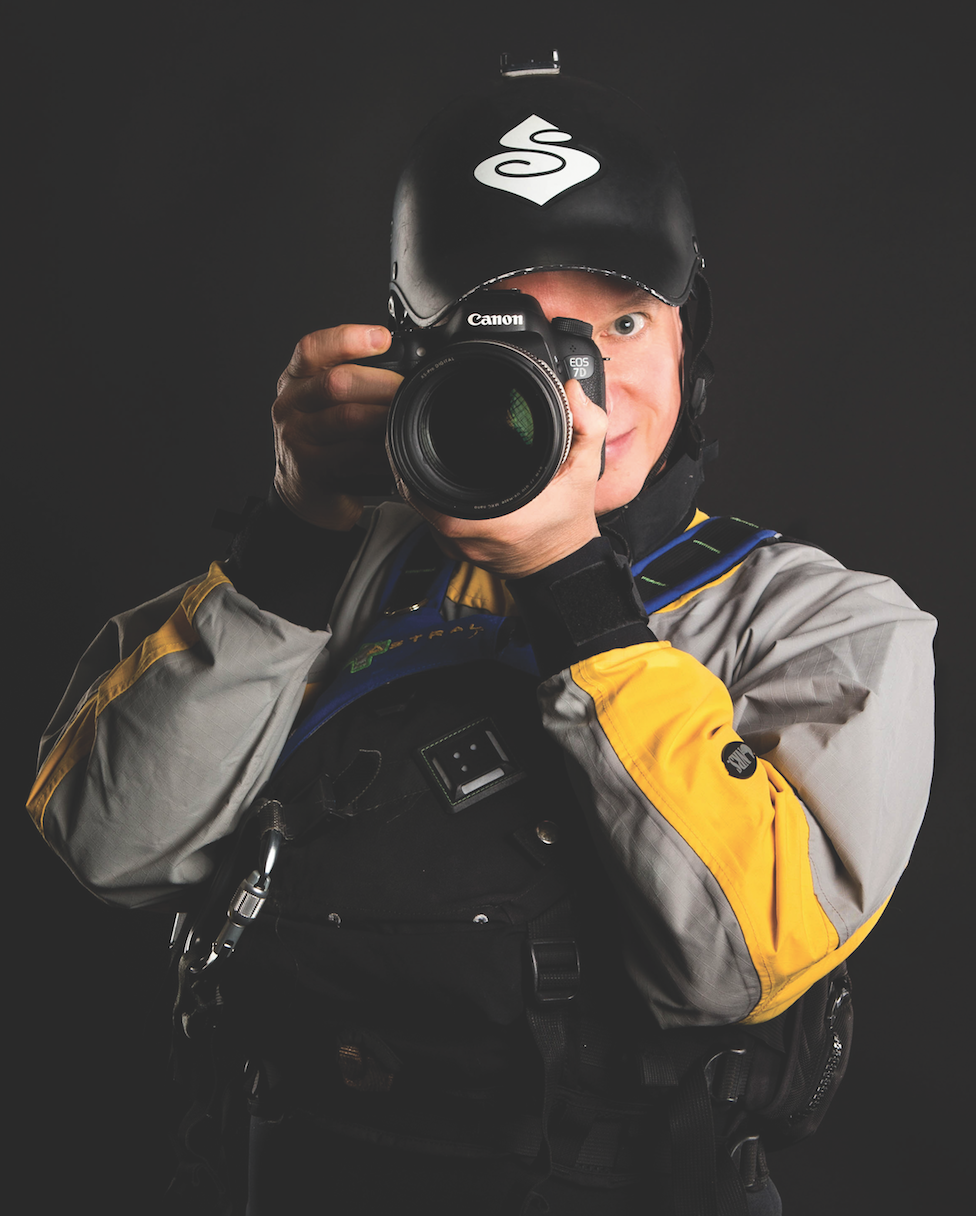
Every fall, the annual Green Race on the Narrows draws hundreds of spectators, kayakers, and photographers to the depths of the Green River gorge. It’s a challenging class V paddle in, and for the crowd, an equally stiff hike.
Being a whitewater kayaker himself, Rob Giersch loves shooting the action-packed event. For years he’d been scheming up ways to get a shot that captured the essence of the Green Race—the cheering crowd, the caliber of athletes, the power of the river at Gorilla. The only way to do that, he figured, was to set up on river right, the riverbank opposite that of the access trail. Because the Narrows mostly runs on a dam release, Giersch would have to wade the river well before the water reached that part of the gorge in order to stage himself.
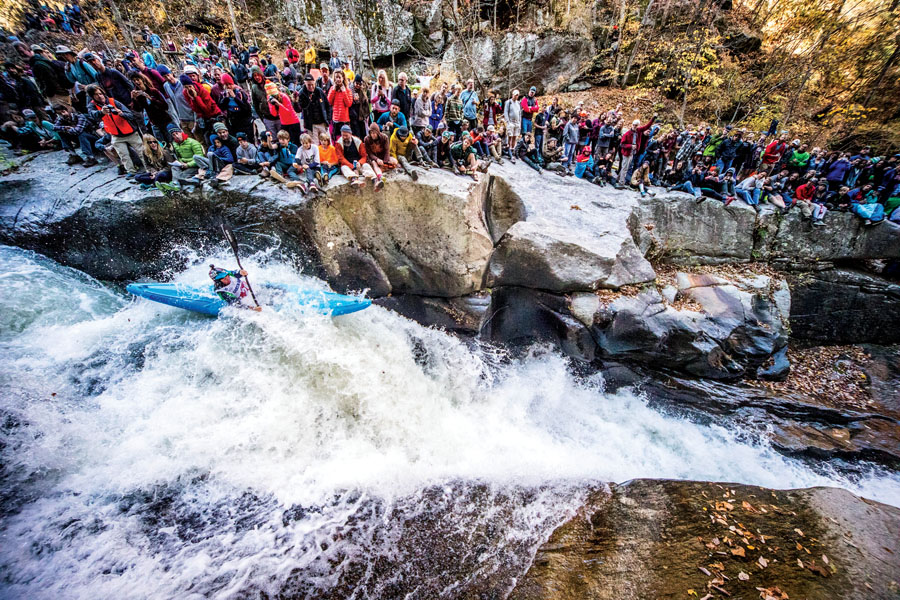
“I slept in the back of my car at the parking lot and started hiking in the dark at 5:30 in the morning,” Giersch remembers. “When I finally got down there, I had to wade across the knee-deep river, alone, with all of the camera gear.”
One slip could have sent Giersch floating downstream, but he made it safely to the other side. River right isn’t as spectator-friendly as river left, with mostly vertical, slick rock to perch upon. Giersh built an anchor and a basic belay, tied himself in, and lowered into the uncomfortable position he would spend the next six hours hanging out in, all for one shot.
“Yeah, it was a lot of work,” Giersch says, “but for me it wasn’t just the picture. Everyone I met that day knew I got the shot, and because of that, my image of the winner ended up in Kayak Session Magazine.”
Rob’s Takeways:
• Get low, get high, do whatever it takes to safely get in a unique position or angle.
• Experiment with a fast shutter to freeze the action and slow shutter speeds with a tripod to accentuate the movement of the river.
• Have the right gear for being on the water.
BEFRIENDING MOTHER NATURE
Based in: Maggie Valley, N.C.
Started shooting in: 2014
Specializes in: outdoor portraits
Shoots on: Sony A7R and A7R II with Zeiss 35mm f/2.8 lens
Most memorable photography faux pas: Leaving a tripod on a mountain after sunrise and having to hike back in to get it.
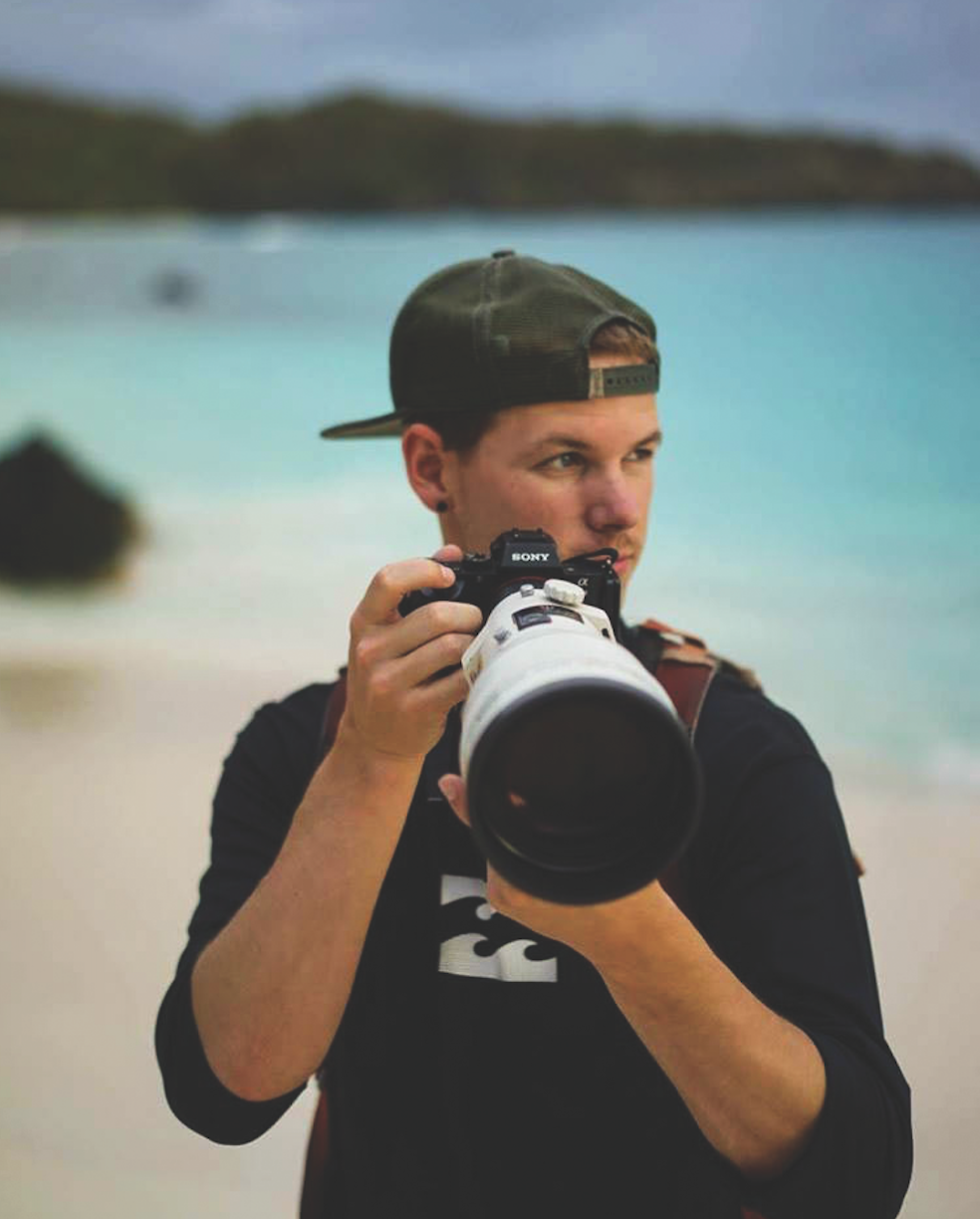
When Steve Yocom isn’t on assignment or trekking into the backcountry with his two pups, Cain and Sage, he’s helping others learn the art he holds so dear. During a photography workshop this past summer, he and his six students learned firsthand how even the worst conditions can open up surprising creative opportunities.
“We were all set up for sunset and I was showing them the elements of a good composition and what to look for, and right before the sun was supposed to set, the clouds blew in,” he says. “It was this foggy, dark mess. We were kinda bummed.”
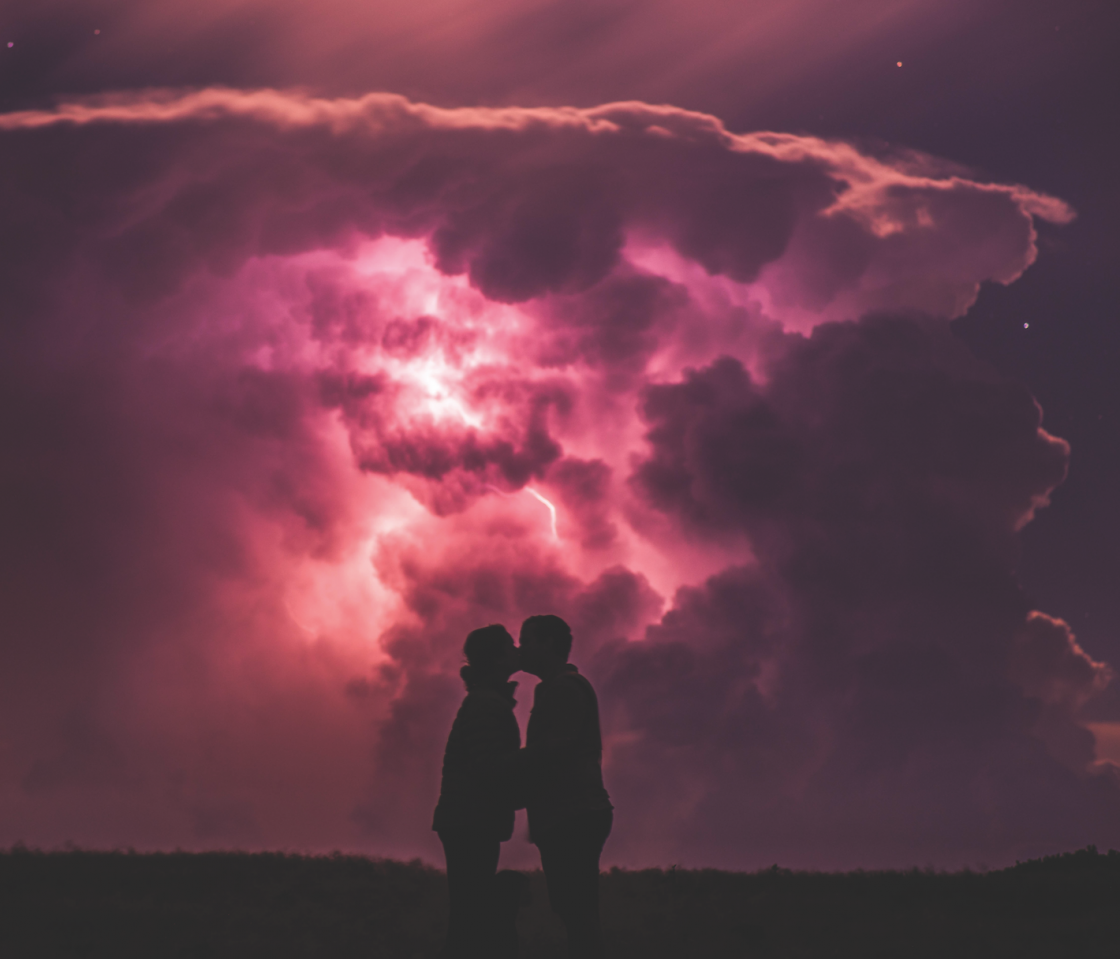
Bummed maybe, but not deterred. The group took a break for dinner, which is when Yocom noticed flashes just over the horizon. Those previously boring gray clouds had taken on a deep purple hue. The thunderclouds mushroomed higher into the sky. He quickly reassembled the group, talked through the exposure, and started shooting.“Lightning had been on my to-do list for quite awhile, and for about 30 minutes it was really firing off,” he says. “The shot was okay just as a landscape, but there wasn’t much of a photo there, so we put a couple in to really make the backdrop pop.”
The resulting portrait is a once-in-a-lifetime moment any couple would be envious of.
Steve’s Takeaways
• Plan and prepare, but be able to adapt.
• Try to achieve balance in your images using the rule of thirds and by establishing something in your foreground, middle ground, and background.
• When shooting lightning, expose for the moment when the bolt goes off. This shot was taken at a low ISO of 100 and a shutter speed of six seconds.
[nextpage title=”Read on!”]
UP SH*T CREEK WITHOUT A CAMERA BAG
Based in: Chapel Hill, N.C.
Started shooting in: 1998
Specializes in: anything with a cool story
Shoots on: Nikon D5 with Nikkor 16-80mm f/2.8 lens
Most memorable photography faux pas: Spending hours rigging a line for a climbing shoot only to find out the gully above turns into a waterfall when it rains.
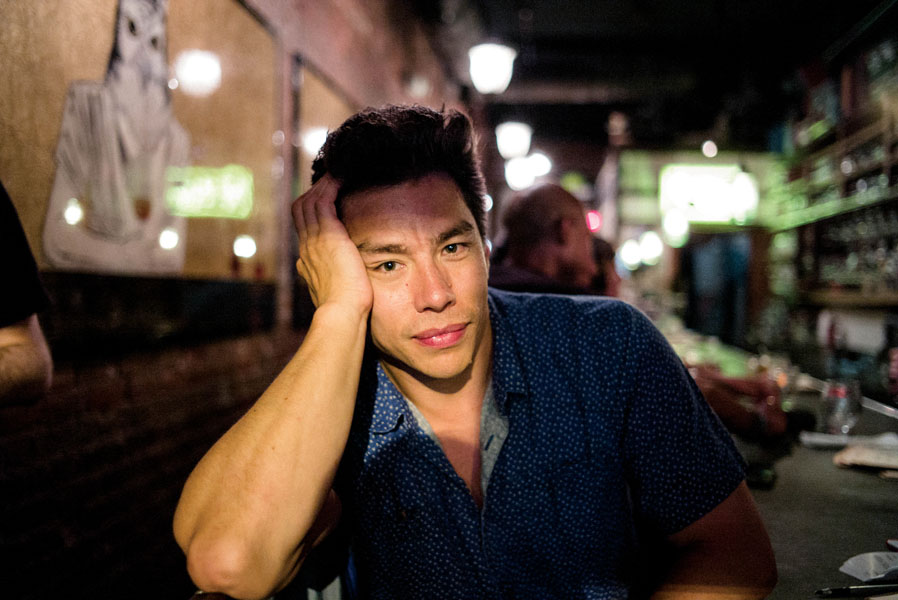
“You can’t forget that when you’re doing adventure photography, 90 percent of it is just being out there. It’s all that mess plus a camera.”
In between shoots this past summer, Andrew Kornylak was reminded of that very lesson. With a few days to kill before a backpacking assignment in the Smokies, Kornylak threw together a fly fishing shoot on the Hiwassee with Allie, a Chattanooga-area rock climber, angler, and photographer, and her family.
Given that the Hiwassee is a dam release river, Kornylak had heard horror stories about anglers getting caught up unexpectedly in the rising river, since the Army Corps occasionally releases pulses unannounced. Allie’s father had even jokingly warned them to “keep an eye on the locals—when the rednecks disappear, you know something’s up.”
But as Allie and Kornylak geared up and waded across the river, that was the furthest thing from their minds. Kornylak stashed his camera bag high on a rock near Allie’s brother Bobby and started shooting. After a while, he noticed something wasn’t quite right.
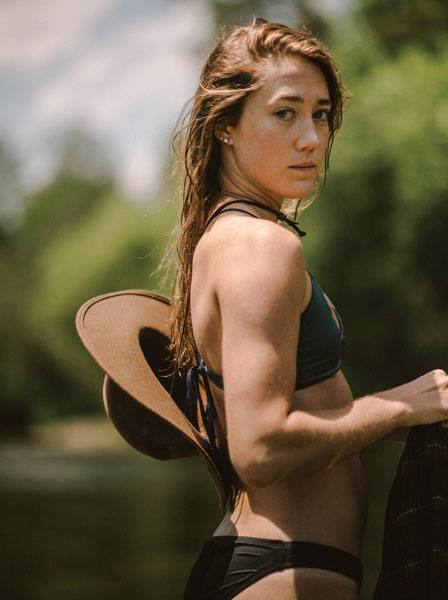
“It felt different. The water was higher. Allie and I both looked up at the same time and realized there was no one else around,” he says. “All of the features we’d been hopping around on were totally underwater,” including the rock where his camera bag had previously been.
Kornylak spotted the bag bobbing downstream toward Bobby. What had earlier been a dried up ledge was now a veritable cascade, and Kornylak’s bag filled with expensive camera lenses was heading right toward it. At the last minute, Bobby saw the bag and pulled it from the water but it was too late.
“Two of my main zoom lenses were just so full of water I could pour them out like coffee mugs,” says Kornylak. “They were totally toast.”
Deflated, Kornylak laid out the other lenses to dry and the group took a break to eat some lunch. When the water levels had dropped again, they went back out, and Kornylak managed to capture some of his favorite portraits of the day.
“It was a real pain in the ass for the next shoot, backpacking in the Smokies for three days. I needed those two clutch lenses. But it all worked out.”
Andrew’s Takeaways
• Don’t let a fear of ruining your gear stop you. Cameras put up with a lot more abuse than you think.
• Collaborate with your subjects and make them an active part of the shoot.
• Hustle as hard as you did the first year you started shooting.
ON ROCK AND ICE
Based in: Asheville N.C.
Started shooting in: 2014
Specializes in: portraiture
Shoots on: Nikon D750 with Nikkor 85mm f/1.8 lens
Most memorable photography faux pas: Letting models look at the images mid-shoot only to have them unknowingly bump up the ISO to 1000—the rest of the day’s images were so noisy!
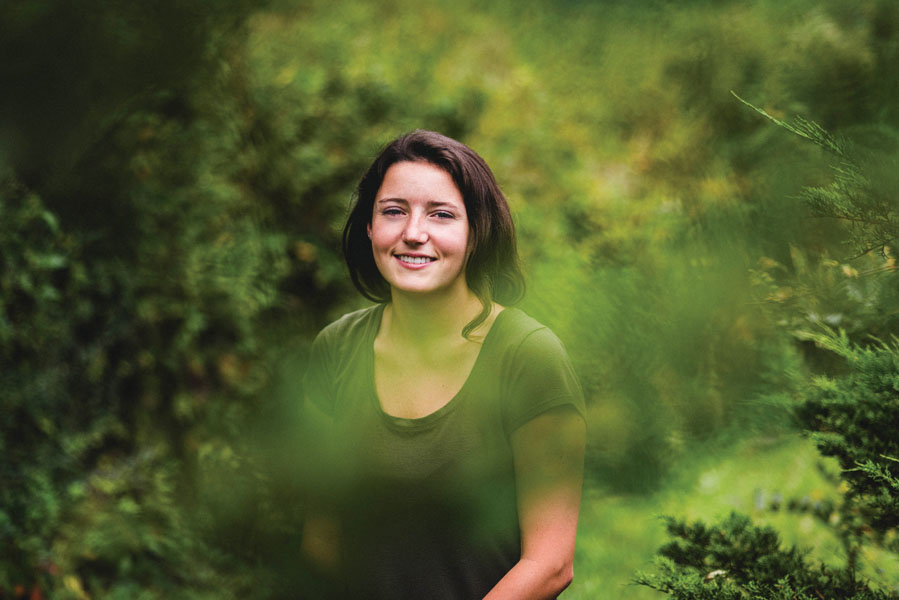
No matter how much planning goes into a shoot, sometimes, life happens. For Yvonne McKenna, life hit in the wee hours of the morning on the day of a big sunrise shoot. The session had already been rained out the day before, so her gear was packed and loaded, ready to roll. Her 3 a.m. brain, however, was not. She accidentally woke up late.
Flustered, McKenna and her model set out for the long and winding drive to Linville Gorge in hopes of making it to the Hawksbill Mountain summit before sunrise. When they got to the trailhead, light was just starting to crest the horizon. Loaded down with tripods, lights, lenses, camera, and softbox, they hit the trail. Inches of ice and snow covered the path.
“We were trying to run up the trail but we were slipping all over the place,” McKenna remembers, “and I did not want to be falling with all of this expensive gear.”
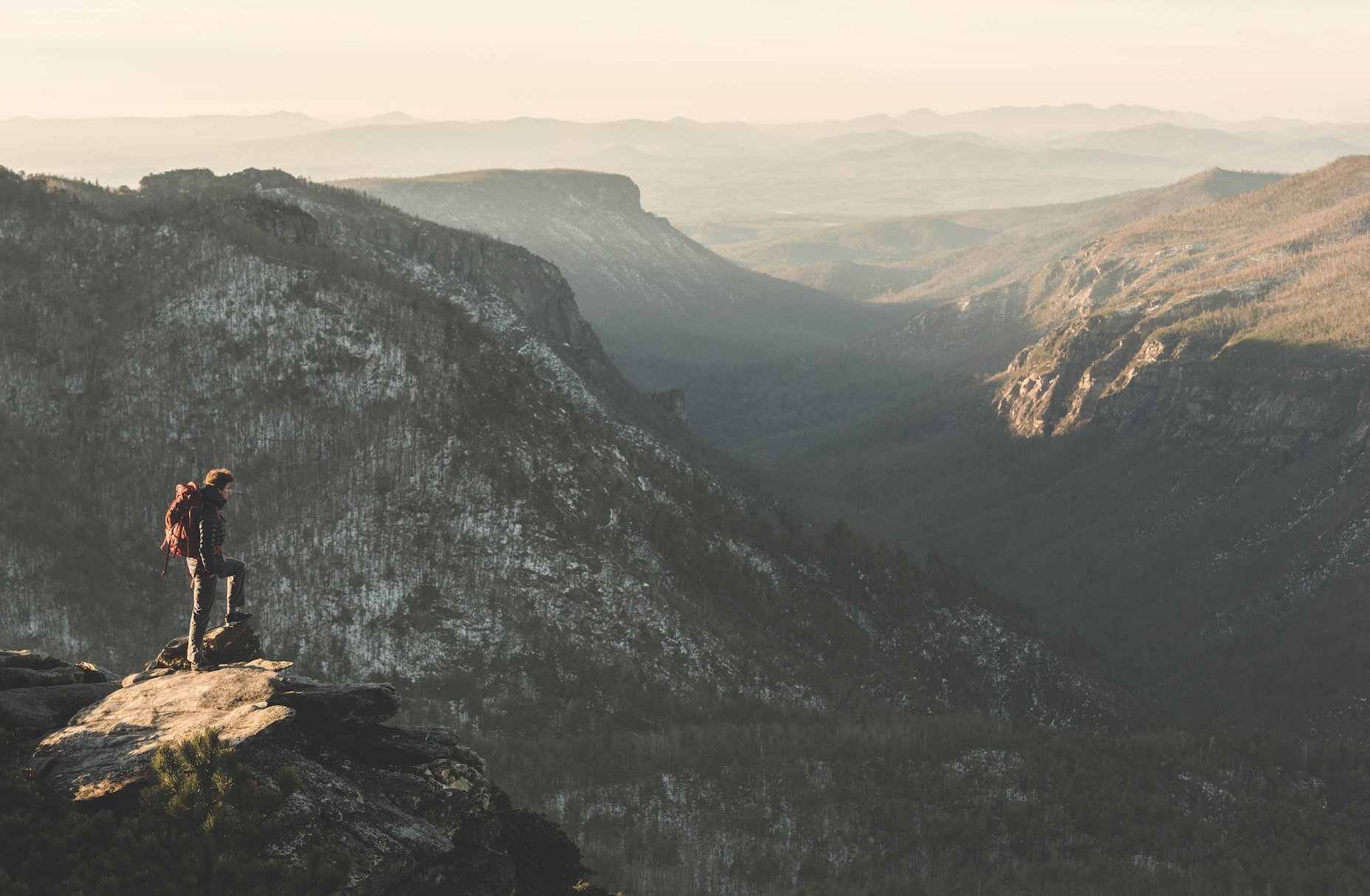
They finally arrived at the overlook just as the sun was starting to rise. McKenna quickly set up the lights and tripod, but between the ice-covered rock and the wind, she had to double down on securing her softbox.
“It basically turned into a kite and I’m trying to wrestle this thing on a ledge. I thought for sure it was just gonna take off.”
Finally, everything was in position, including her model. She took a couple shots, adjusted her settings and angle, took a few more shots, and then, the battery on her Profoto B1 light died.
“At this point my lenses were fogging up, the light is moving fast, the batteries won’t hold a charge, my fingers are frozen, I’m terrified for [my model] Dylan who is standing on this sketchy ice ledge. I was honestly able to do 15 shots before the light would die,” she says. “I was really saving those clicks.”
Yvonne’s Takeaways
• Back up your work in at least three places. You’ll never see someone freak as much as a photographer whose hard drive has just failed.
• Bring extra batteries.
• Shoot anything and everything and in all types of weather.
[nextpage title=”Read on!”]
AT THE END OF THE LINE
Based in: Saluda N.C.
Started shooting in: 2012
Specializes in: kayaking
Shoots on: Nikon D750 with Tamron 15-30mm f/2.8 lens
Most memorable photography faux pas: Bringing an empty camera bag to a shoot.
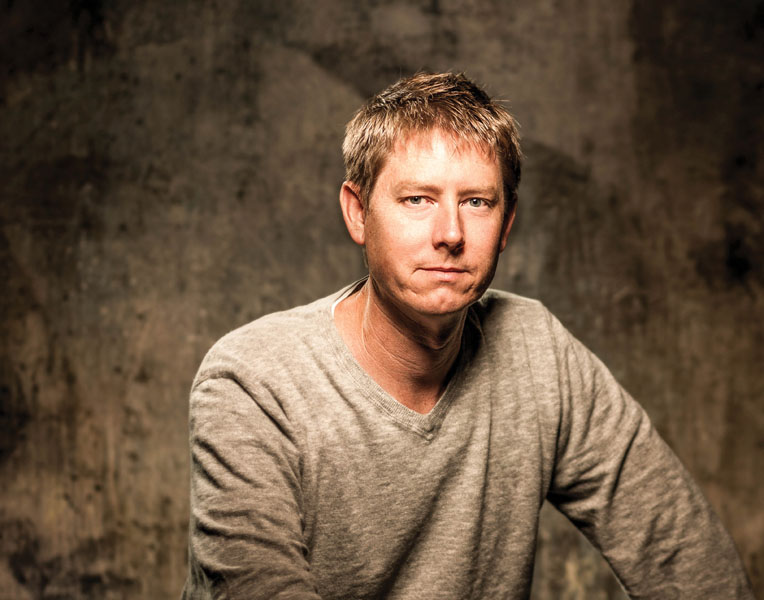
The Green River is Chad Blotner’s literal backyard. Nearly every weekend he’s down in the Narrows shooting kayakers. Blotner’s go-to lens is a wide angle—he likes to get as close as he can to the action. Though not a paddler himself, Blotner saw the possible hazards of getting up close and personal to kayakers paddling class V rapids. In what’s arguably the smartest move he’s ever made in his photography career, Blotner finally ponied up the cash for a PFD and throw rope to anchor himself to the rock…just in case.
“There was a rock at the base of Gorilla where I could shoot a seal launch and also kayakers coming through the rapid, and I always wanted to get down there but I knew if I fell in I would lose all of my gear and my life if I wasn’t careful,” Blotner says.
So after purchasing the gear, Blotner decided to take the chance. He gingerly lowered himself onto the rock, tied his vest to the fixed throw bag, and started shooting. He photographed countless kayakers soaring off the seal launch into the water, turning at the last second to avoid their splash.
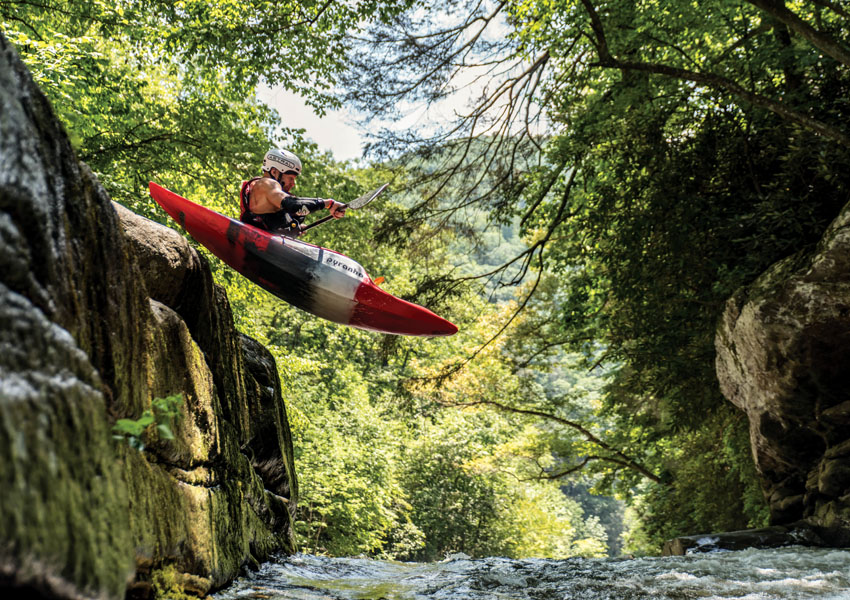
He was just about to wrap up when the final kayaker of the day slid off the rock face and into the water. Blotner nailed the shot, twisted away from the spray—and then his foot slipped.
“When I went to turn I lost my footing and fell on my stomach,” he remembers. “I stuck my hand with the camera in it up above my head and tried to get my footing but that rock was so slick. About the time I grabbed the rope with my other hand, the rope tensioned. It was pretty scary. Nobody else was there. If I had got into that rapid, what would have happened?”
Chad’s Takeaways
• Be aware of your surroundings.
• Use elements of the river to establish a sense of place.
• Always bring a headlamp.
TRY, TRY, TRY AGAIN
Gabe DeWitt
Based in: Morgantown, W.Va.
Started shooting in: 2005
Specializes in: people and places
Shoots on: Nikon D800 with a Nikorr 35mm f/1.4 lens
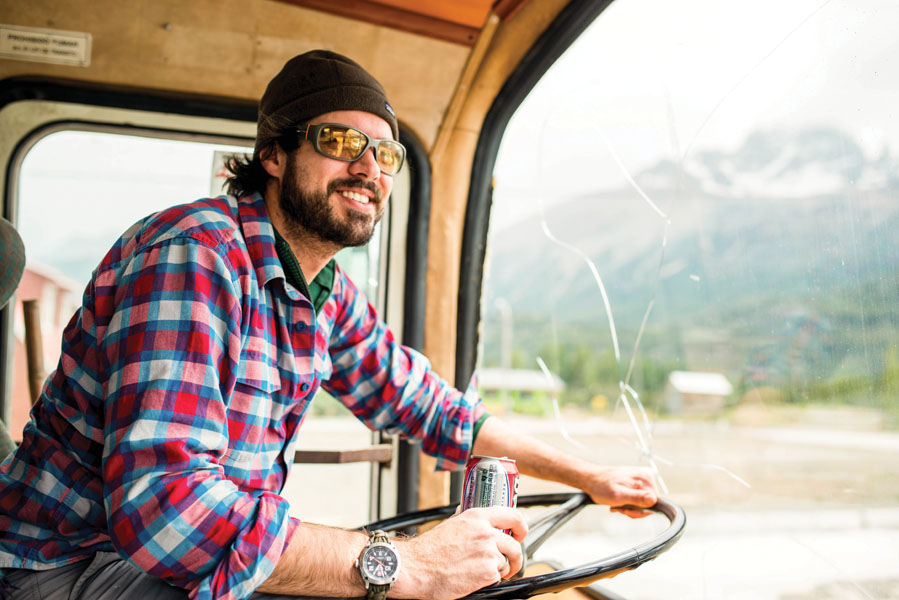
Most memorable photography faux pas: Leaving about $900 of gear on top of the car and getting scammed out of $120 on Craigslist to get it shipped back by the person who had “found it.”
An engineer by trade, Gabe DeWitt is a master tinkerer. When he first started shooting, he took mostly macro photos of plants and animals that demonstrated scientific or mathematical principles. A climber at heart, DeWitt eventually married his passions for the outdoors and photography.
Of particular interest to DeWitt was the niche sport of squirt boating. Whereas most whitewater paddlers aim to stay above water, squirt boaters paddle a low-volume craft with the goal of completely submerging both vessel and paddler. DeWitt was intrigued. Few people had ever captured the essence of squirt boating, let alone been able to see what goes on underwater. After taking the dive and purchasing underwater camera housing, DeWitt decided to give it a go.
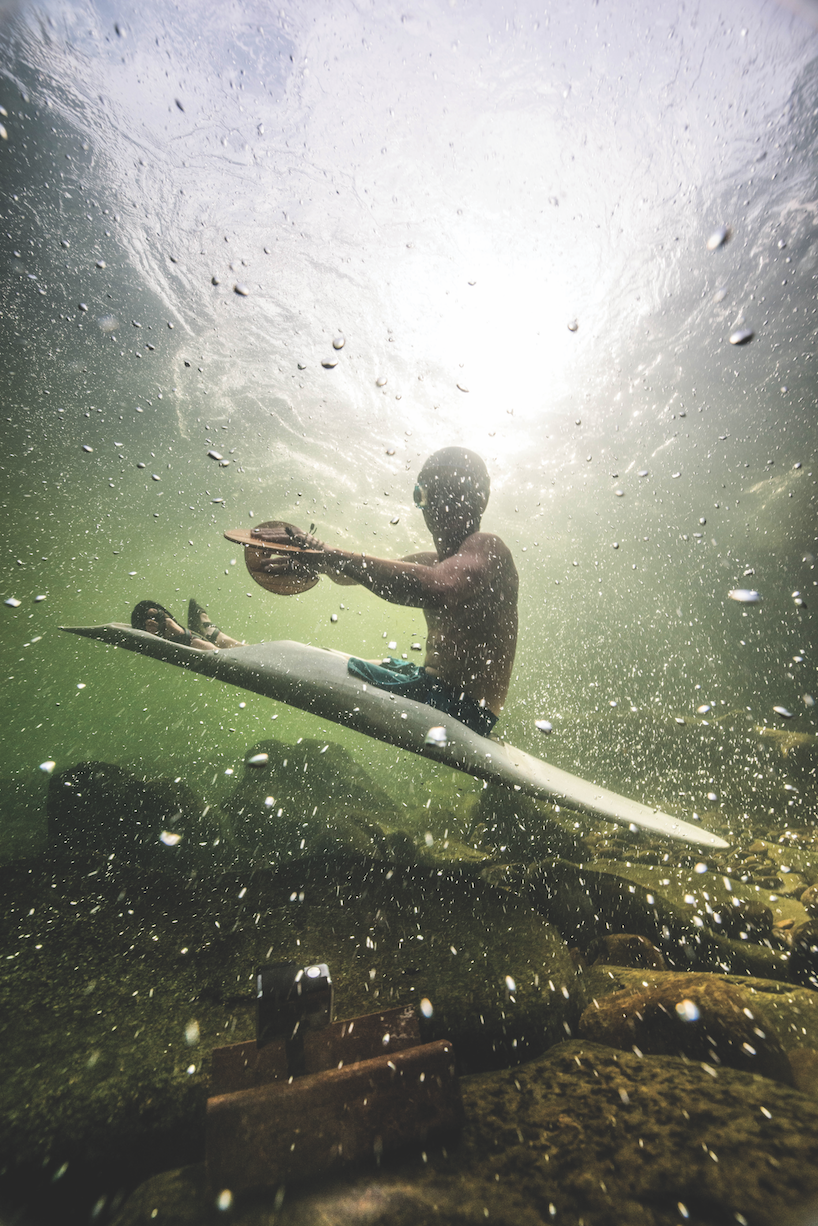
“It was hard because the camera isn’t something you can hold steady. You’re doing everything you can to brace yourself,” he says. “I literally had a finger jammed in some boulders, trying not to get swept away, and I couldn’t really see what I was doing. It was a lot of guessing and checking, guessing and checking.”
DeWitt tried on multiple occasions to shoot his squirt boating friends at Fascination Alley on the Cheat River Narrows, but with little success. More often than not, the lighting was too dark or the river level too high. But about the fifth time he went out, the stars aligned. His resulting series of images feel almost ethereal and out-of-this-world, capturing never-before-seen glimpses into the sport’s signature “Mystery Move.”
Gabe’s Takeways
• Don’t forget to shoot for yourself. Do the stuff that keeps you happy.
• Have your camera accessible always and shoot when it’s not convenient.
• Think, WWTKD, or “What would Tim Kemple do?” Find a photographer you admire, and emulate their style.\
[nextpage title=”Read on!”]
IN THE EYE OF THE STORM
Based in: Spruce Pine, N.C.
Started shooting in: 2013
Specializes in: landscapes
Shoots on: Canon 6D with Canon 24-105 f/4.0 lens
Most memorable photography faux pas: Meeting up to shoot and learn from a professional photographer but forgetting to bring a camera.
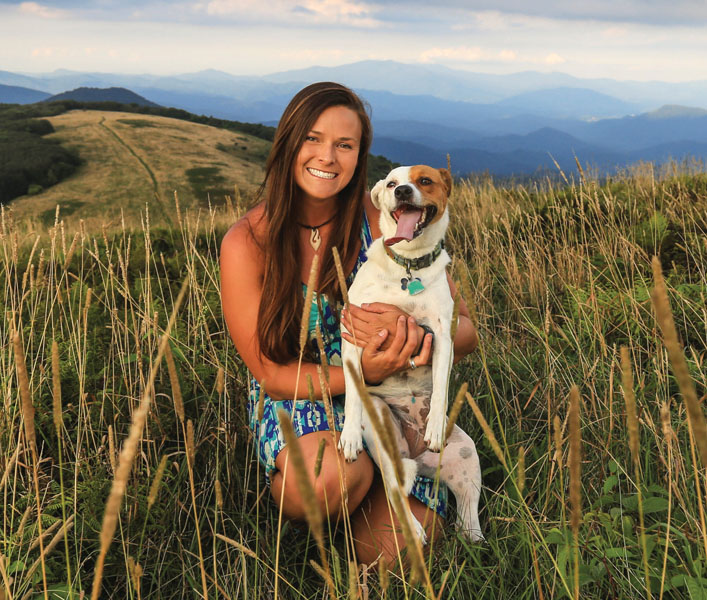
Early on in her photography, Burleson admits to knowing very little about how cameras worked. A trip to Peru back in 2012 proved she would need more than just a nice camera to make memorable shots. After a year of trial-and-error shooting and some helpful pointers from professional photographers, Burleson set out on the summit hike to Mount Mitchell, a stout 5.6-mile climb of 3,600 feet to the East’s tallest peak.
“This was the first time I was carrying all of my camera gear along and I really didn’t have a great understanding about how heavy it would all end up being,” she says. “About halfway up the trail I was already kinda dying and exhausted and finally realizing that I had brought way too much stuff.”
Like some cruel joke from the universe, the sky turned jet black. Burleson donned her rain jacket, but it hardly sheltered her from the monsoon. Thunder roared so loudly, she could feel the vibrations beneath her feet. Determined not to quit on her first photo outing, Burleson gritted her teeth and kept slogging up the trail. When she arrived at the summit, it was of course completely socked in on all sides. Totally spent and thoroughly disappointed with the turn of events, Burleson bummed a ride from her ranger friend back to the trailhead.
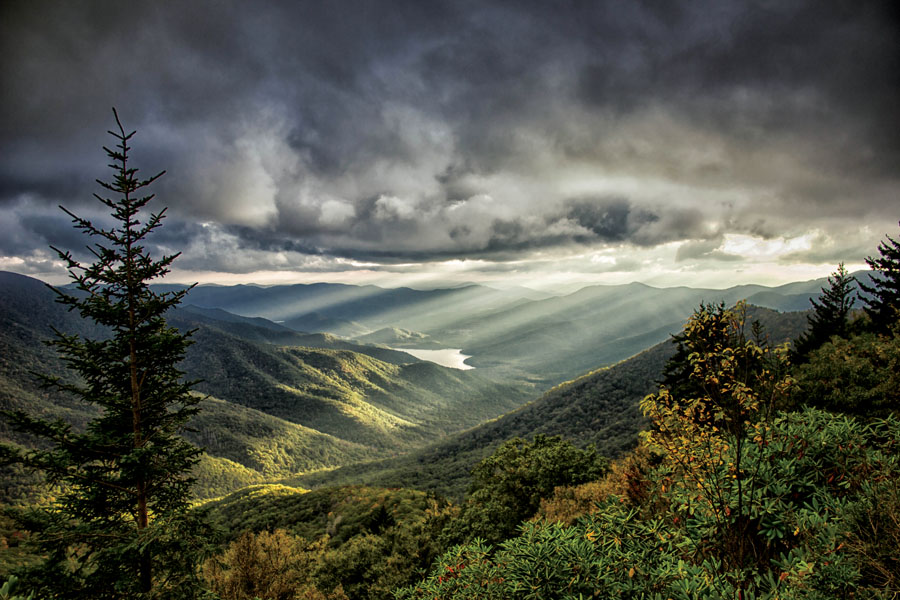
“I hadn’t taken any photos that day at all,” she says. “As we were driving down the road, we came out of the clouds and saw it was going to be pretty. The birds started chirping, the clouds parted, sunrays came streaming through. We could still hear the thunder all around but it was so amazing.”
Halley’s Takeaways
• Don’t weenie out. If you work hard enough, the reward will come.
• Don’t get so wrapped up in the image that you miss the moment.
• Carry hand warmers always.
EXPECT THE UNEXPECTED
Based in: Roanoke, Va.
Started shooting in: 1996
Specializes in: active lifestyle
Shoots on: Canon 5D Mark IV with Canon 24-70mm f/2.8 lens
Most memorable photography faux pas: Shooting mountain biking at Carvins Cove and leaving a fully loaded camera bag, open, at the top of the trailhead. It was still there the next day.
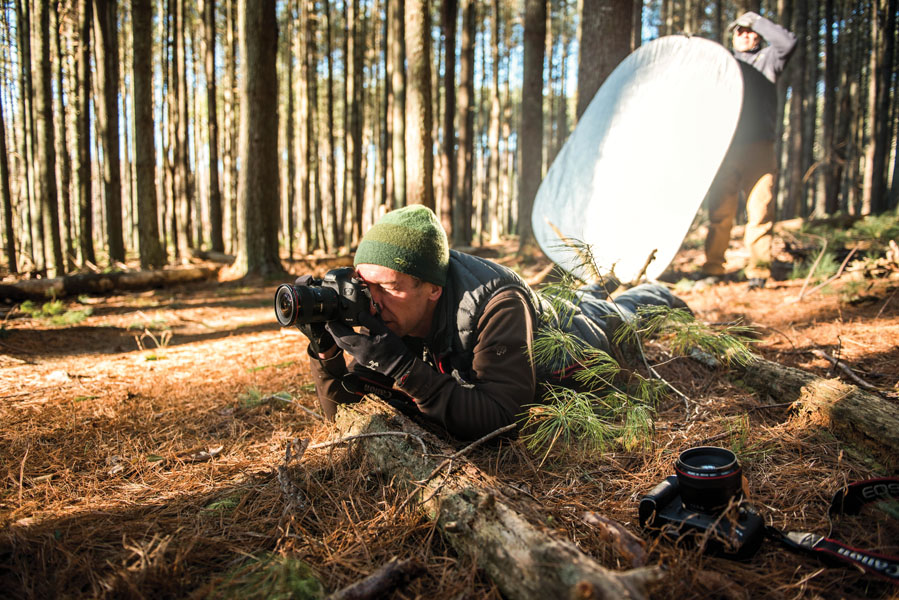
Waking before dawn and staying up well past sunset is hard on anybody, but try doing that seven days straight with the added demands of hiking, camping, and client expectations.
“Sleep deprivation is definitely a factor,” says Sam Dean. “It always seems like whenever you have epic outdoor moments, there’s some sleep deprivation involved.”
What separates the pros from the novices is how well you can cope when everything seems to be going wrong. On the fourth day of a week-long tourism shoot last year, Dean thought for sure he was getting skunked on a sunrise.
“Summertime in the Appalachian Mountains, you know you’re always gonna get some rain at some point,” he says. “Lo and behold as soon as we got to the top of Grandfather Mountain, here comes this massive crackling terrifying storm. It felt like the mountain had fireworks going off all around.”
Dean headed for tree cover and stayed perched on his Therm-a-Rest for hours, “just hoping we weren’t gonna get zapped.” He finally got some shuteye, but when he woke a few hours later, the morning was looking to be just as bad, a veritable fog machine.
He wasn’t ready to throw in the towel just yet. He convinced one of the models to hike up the ladders with him to the ridgeline. When they reached the top, Dean knew he’d made the right call.
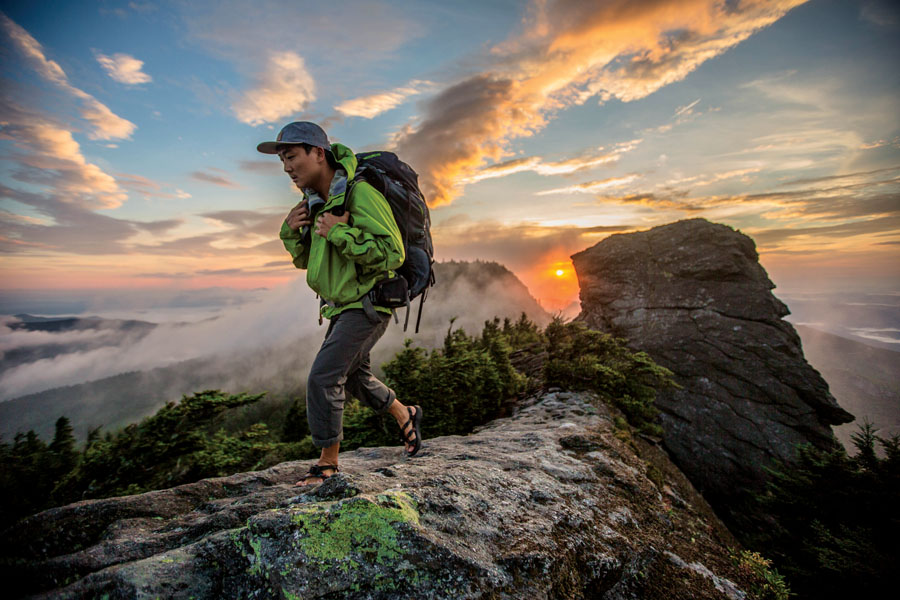
“It was just mind-blowing the way the storm was clearing and wrapping around the different sections of rock,” he says. “We were just dumbfounded by this once-in-a-lifetime sunrise. I’ve seen a lot of sunrises and sunsets and this was just amazing. It was a good lesson in never giving up.”
Sam’s Takeways
• Four things go into a memorable image: location, talent, lighting, and “the moment.” If you start eliminating any one of those things, you can still have an image, but it’s going to be less powerful.
• Hide a 64 GB SD card somewhere in your camera bag, in case you have a brain fart.
• Don’t give your work away for free. If you don’t value your work, no else is going to and you’re doing a disservice to the community at large.
[nextpage title=”Read on!”]
KEEPING UP WITH THE PROS
Based in: Boone, N.C.
Started shooting in: 2013
Specializes in: landscapes and outdoor lifestyle
Shoots on: Canon 6D with Canon 24-105 f/4.0 lens
Most memorable photography faux pas: Backpacking three miles in to shoot sunrise in the Linville Gorge but forgetting to bring memory cards.
Since picking up a camera, Justin Costner has bushwhacked, crawled, climbed, and forded his way inside and out of the Linville Gorge. It’s this intimate knowledge of Linville that made him the perfect photographer to shoot climbing rock stars Jenny Abegg’s and Sarah Gaskins’ speed record attempt of the Linville Crusher.
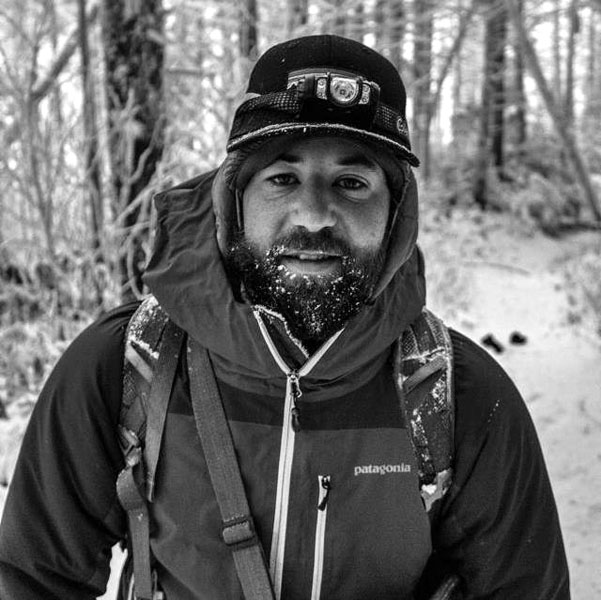
The Linville Crusher is the linkup of six major formations on the eastern side of the Gorge—Sitting Bear, Hawksbill Mountain, Table Rock, North Carolina Wall, the Amphitheater, and Shortoff Mountain—all in a day, and all without driving. Jenny and Sarah, both accomplished climbers, wanted a sub 12-hour Crusher, and they wanted Costner to help document it.
“Trying to keep up with these real deal professional athletes was a super physical test for all of us,” says Costner. “We were out there covering over 20 miles with our weighted packs and hanging on ropes right there with them.”
The team, which included Jenny, Sarah, Costner, and two other shooters, started out first thing in the morning. From the tortuous afternoon heat, which rose well into the upper 80s, to the brutal terrain, the entire team was exhausted by the time the ladies finished some 10 hours and 27 minutes later.
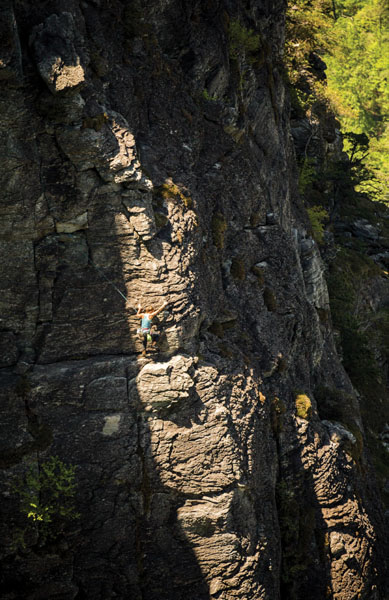
“We were seriously whooped,” says Costner. “We could barely walk at the end of the day. But even through the logistical problems, it was amazing to see our plan come to fruition and it was by far one of the most memorable days out in the mountains I’ve ever experienced.”
Justin’s Takeaways
• Be just as fit (if not more so) than the athletes you are shooting.
• Find a subject that inspires you and let that determine your path.
• Be kind to our wild spaces out there. Take only photos and leave no trace.
RACING THE CLOCK
Based in: Asheville, N.C.
Started shooting in: 1997
Specializes in: high-end furniture professionally, outdoor sports off-the-clock
Shoots on: Nikon D800 with Nikkor 17-35mm f/2.8 lens
Most memorable photography faux pas: Getting a late start up Looking Glass and not bringing any waterproof camera protection.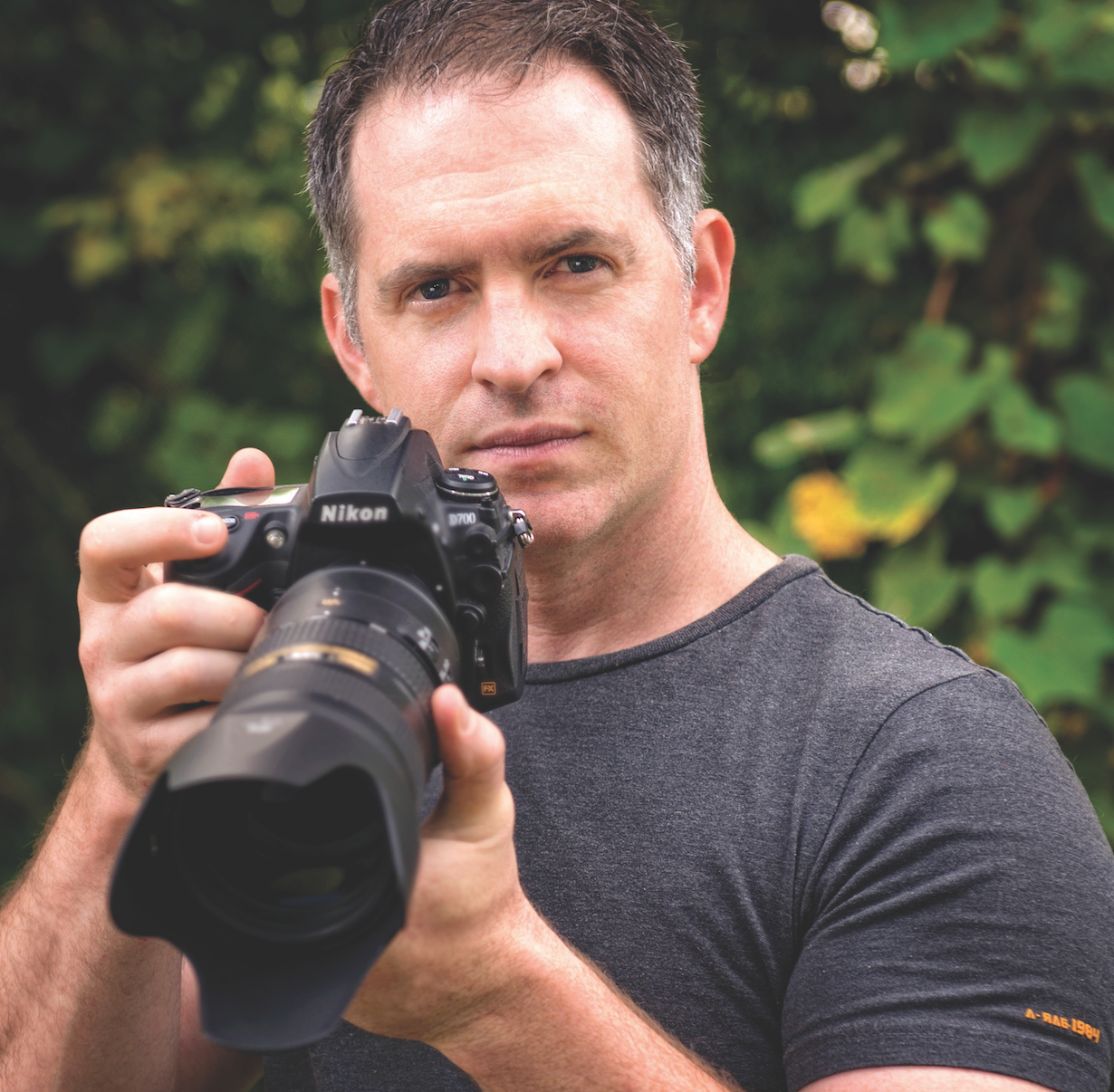 When Shannon Millsaps is not on commercial shoots for high-end furniture or architecture clients, he’s usually on some North Carolina rock, jumaring his way up and down a route to get the shot. You’ve probably seen his images of the Triple Crown Bouldering Series, which he’s photographed for nearly a decade.
When Shannon Millsaps is not on commercial shoots for high-end furniture or architecture clients, he’s usually on some North Carolina rock, jumaring his way up and down a route to get the shot. You’ve probably seen his images of the Triple Crown Bouldering Series, which he’s photographed for nearly a decade.
Last summer, Millsaps was part of a large crew climbing out on Looking Glass Rock near Brevard, N.C. Afternoon thunderstorms are common in the summertime, and it’s well known that if you want to beat the rain, you should be off the rock by 2 p.m. Millsaps’ group was right on the cusp of that afternoon cutoff and approaching the last pitch when he saw a major storm system building on the horizon.
“You could see the rain and it was thundering and lightning but it was still over the mountains,” he says. “We still had to get a couple of parties to the top, but time was of the essence because you’re just so exposed up on that dome. We were basically racing the clock at that point.”
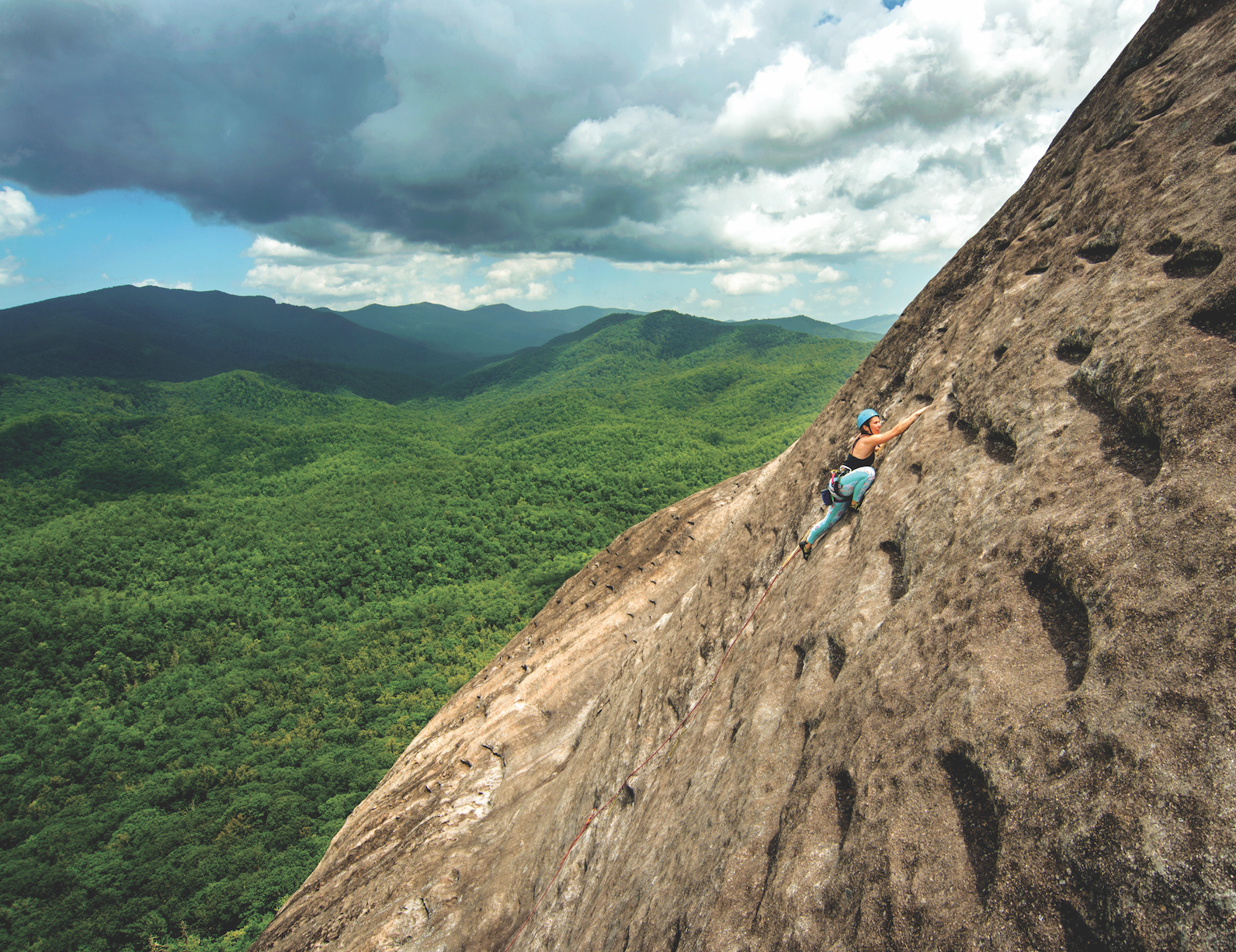
The group hustled, safely rappelling off the dome and not a minute too soon. As soon as the last team member hit the ground, lightning struck nearby. Though the rain never came in droves (luckily, for Millsaps’ camera), the lightning continued to blast. Millsaps later heard that another climbing team on the opposite side of Looking Glass wasn’t so lucky.
“They didn’t get off in time and were stuck up on the wall, forced to hang out and deal with these super close lightning strikes.”
Shannon’s Takeaways
• Start earlier than you think you need to.
• Experiment with new techniques, cameras, and equipment.
• Capture the subject’s face and eyes to transport viewers into the scene.
[nextpage title=”Next Page”]
Astrophotography Crash Course by Tommy White
Tommy White of Boone, N.C., has been a full-time landscape photographer for over a decade. He’s seen the transition from film to digital and DSLR to mirrorless. We caught up with White in between photography workshops to get schooled on nighttime photography and how you, too, can capture the stars.
https://www.instagram.com/p/BG7-iFUCB4C/?taken-by=tommytwhite
- Don’t forget your composition. “You want to lead the viewer through your scene, be it with supporting elements for your main subject or differentiating between lights and darks,” says White. “Rather than it being just a pretty picture, use the Rule of Thirds or build a pyramid with shapes and lines to grab the viewer’s attention.”
- Do your research. Fortunately, there are a few apps that help photographers and stargazers keep tabs on the celestial skies. Stellarium and PhotoPills are both useful tools for learning, and shooting, the Milky Way.
- Shoot on the new moon. “The ideal time to shoot the Milky Way is when the sky is very dark,” says White. “You can also shoot with a quarter moon, as long as it’s not dominating the sky.”
- If the moon is out, put it over your shoulder. “That can be a really great way to light up some of the landsape in front of you,” says White, “and I’m a big advocate of having something in the foreground. I don’t shoot just the Milky Way.”
- Use the 500 Rule to avoid star trails. White typically sets his starting ISO around 3200, his aperture at 1.8, and his shutter speed to 20 seconds (all on a 24mm lens). That, he says, is right in line with the 500 Rule, which is a simple formula for calculating your shutter speed. Simply divide 500 by your lens’ focal length to get the longest exposure in seconds before the rotation of the Earth comes into play.
- Shoot March through October. In this part of the world, these eight months are when the most iconic part of the Milky Way is still visible. “Sagittarius is really the juicy part of the Milky Way with that little pop of color,” says White. “After October that part sinks below the horizon.”
- Rubber bands and hand warmers are necessities. It’s the Southeast. Humidity is your biggest enemy, and hand warmers are your best ally in combatting condensation.
[nextpage title=”Next Page”]
SO YOU WANNA SHOOT FALL FOLIAGE?
Check out these tips from veteran landscape photographer Jeff Greenough of Christiansburg, Va,. before heading out on your next leaf peeping adventure!
https://www.instagram.com/p/9tj0OKMoUc/?taken-by=jeffgreenough
- The best camera you have is the one that’s on you. “I don’t feel ashamed if I have to take an image with my iPhone because photos make you remember,” says Jeff Greenough. “Take time to create those memories.”
- Use weather apps. Like it or not, technology has infiltrated nearly every aspect of our lives. Might as well put it to use before you spend the weekend on the hunt for colors. “The NOAA Weather Radar app is the best to look at,” says Greenough.
- Don’t be scared of a little rain. First off, it’ll keep the drive-by tourists at bay, and secondly, those moody skies can really make those reds and oranges shine. “Clouds are your friends. Even lighting patterns allow the colors to pop.”
- Make it hard. Most leaf peeping crowds gravitate to areas that are easily accessible. Work for your views, or at least hike a few extra yards away from the masses, and you’ll probably stumble upon an equally stunning scene. “If you see something that looks easy, go to a different spot,” says Greenough. “A lot of times we have that herd mentality, but photographers are true problem solvers. The more they make mistakes and try things and move around, the better their images.”
- Know your elevation. Where you live could be higher or lower in elevation than where you’re planning to shoot. The general rule of thumb is that higher elevations turn to peak color before the lower elevations. Start high and work your way down. “If you’re seeing pictures on social media of peak colors in Waynesboro, which is at 1,200 feet, that doesn’t mean Charlottesville, which is closer to 600 feet, will be the same.”
- Invest in filters. Neutral Density (ND) filters allow you to play with slowing down the motion of water, for example, while circular polarizing filters help alleviate harsh reflections and glare on wet leaves.
- Make your subject stand out. Greenough primarily shoots landscapes, sans human, but if you do put a person in your shot, take into consideration the color of their jacket or gear and make sure it contrasts the warm-colored background.
